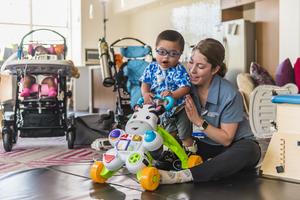
Health care innovation continues to move at a fast pace with a variety of developments over the years, especially in digital health. However, the pediatric field has not benefitted as much from these types of solutions simply because one size doesn’t fit all.
How might we create big solutions for our smallest patients?
The Children’s Innovation Lab, in collaboration with other labs and clinicians, will create digital solutions that meet the unique needs of young people and their families both in and outside the hospital.
By testing ideas and prototypes with children and their caregivers, the lab will develop products and services that make significant strides in pediatric care.
Meeting the needs of children
- Pulmonary Acoustic Telemetry: Constantly collecting vital signs in the hospital space such as heart rate, blood pressure and pulse oximetry is fairly easy using medical devices designed for such use. However, there isn’t a great way to capture recordings of lung function without a physician physically being present. The Children’s Innovation Lab is developing sensors that can constantly monitor lung function while also classifying sounds that can indicate respiratory changes. The sensors will also create a 3D representation of where lung sounds are coming from, helping a physician pinpoint issues.
- Flight Path: Determining whether a child has a neurological condition is difficult, as standard neurological exams are often unable to pinpoint precise diagnoses. The Children’s Innovation Lab is developing a new way to measure a patient’s perception, cognition and motor function by use of an augmented reality app. Named “Flight Path,” the platform engages a child in a neuro exam by having them use a mobile device to follow and capture a hummingbird as it flies around the room. Movements made by the patient will be automatically analyzed to indicate motor, perceptual and cognitive impairment.
- Improving Child Vaccination Rates: A glaring problem that has surfaced as a result of the COVID-19 pandemic is a declining rate of childhood vaccinations. This leads to an increased risk for vaccine-preventable disease outbreaks, especially for children who are immunocompromised or have certain autoimmune conditions. The Children’s Innovation Lab will use pandemic and vaccination data to create a heat map showing areas of under-immunized children within OSF HealthCare service areas. The goal is to optimize delivery of vaccination resources.
Help us advance solutions for pediatric care!
If you are interested in learning more about the Children’s Innovation Lab, participating in certain aspects of the journey, or if you want to invest or partner, contact us today.
Leading the Way

